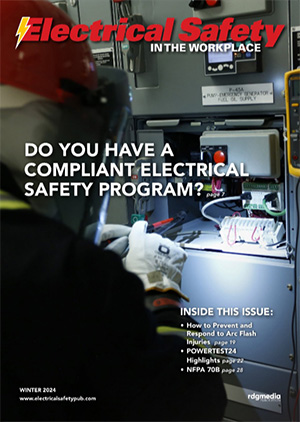Update: Changes to NFPA 70E® 2021 Edition
What You Need to Know to Stay Current
By Steve Edwards & Jay Smith, Contributors
 The National Fire Protection Association’s 2021 (NFPA) 70E® Standard for Electrical Safety in the Workplace® has been updated and is now in effect. NFPA 70E® is one of the most widely used consensus standards in U.S. workplaces. The standard has a comprehensive scope (the 2021 standard is 100+ pages), addressing electrical safety-related work practices, safety-related maintenance requirements, and administrative controls to protect employees from electrical shock and arc flash. The standard covers every part of electrical work from voltage measuring and troubleshooting on both ac and dc systems, de-energizing equipment, and verifying the absence of voltage before any work is done.
The National Fire Protection Association’s 2021 (NFPA) 70E® Standard for Electrical Safety in the Workplace® has been updated and is now in effect. NFPA 70E® is one of the most widely used consensus standards in U.S. workplaces. The standard has a comprehensive scope (the 2021 standard is 100+ pages), addressing electrical safety-related work practices, safety-related maintenance requirements, and administrative controls to protect employees from electrical shock and arc flash. The standard covers every part of electrical work from voltage measuring and troubleshooting on both ac and dc systems, de-energizing equipment, and verifying the absence of voltage before any work is done.
NFPA70E standard is revised every three years. The 2021 edition of NFPA 70E® was issued on June 1, 2020 and became effective June 21, 2020. The changes are important for every electrical worker to understand so they can keep in compliance and stay safe on their jobs.
A Look at the Revisions:
- Some of the 2021 revisions have been reorganizing. For instance, Article 110 of the standard – General Requirements for Electrical Safety-Related Work Practices — has been revised to consolidate general requirements for electrical safety-related work programs, practices and procedures from other articles. The first priority in implementing these work practices is hazard elimination. Energized electrical conductors and circuit parts operating at voltages equal to or greater than 50 volts are to be put into an electrically safe condition before an employee performs work if the individual is within the limited approach boundary and/or the individual interacts with equipment where conductors or circuit parts are not exposed but an increased likelihood of injury from an exposure to an arc flash hazard exists.
- Electrical safety training for employees exposed to specific hazards associated with electrical energy is to be classroom-based, on-the-job, or a combination of the two. New to the 2021 edition: classroom training can include interactive electronic or interactive web-based training components.
- The 2021 70E® edition places a new emphasis on keeping on file, documenting, and following the recommendations of electrical equipment and PPE manufacturers’ instructions. Manufacturers’ instructions sometimes have been skipped because the information might be hard to access, forcing workers to dig through equipment packaging, or small print instructions have made readability difficult. Manufacturers must now make instructions and recommendations more readable and more accessible.
- Personal protective equipment (PPE) constitutes part of NFPA 70E®. PPE includes nonconductive head protection, eye protection, hearing protection, and arc-rated clothing whenever there is possible exposure to an electric arc flash, insulating blankets, and non-melting footwear. The 2021 edition addresses the common practice of wearing high-visibility vests over arc rated clothing. In the past qualified workers that were required to wear high-visibility vests had to remove the vests if the vest did not meet the level of arc flash protection required. Now qualified workers can wear a category 1 arc rated high-visibility vests (4 cal/cm2) during the workday and not have to remove it to perform electrical troubleshooting or voltage measurements
- Acceptable electrical safety footwear has been expanded in the 2021 edition to go beyond traditional leather footwear to include other types footwear other than leather or dielectric as long as it has been tested to demonstrate no ignition, melting, or dripping at the estimated incident energy exposure or the minimum arc rating for the respective arc flash PPE category.
- In addition, the definition of balaclava has been changed. The word “hood” and “sock” were removed. The new definition: an arc-rated head-protective fabric that protects the neck and head except for a small portion of the facial area.
Circuit Breaker Safety and Battery Safety
Circuit breaker safety and battery safety have new requirements in the 2021 edition. When circuit breakers are initially switched on after installation or after maintenance has been completed, operators are now required to wear appropriate arc-rated PPE. This change affects potentially every maintenance employee in a workplace.
Also, circuit breakers that interrupt faults approaching their interrupting ratings are to be inspected and tested according to the manufacturer’s instructions.
The ever-increasing power of batteries (in particular lithium batteries) is addressed in the 2021 edition. Energy exposure levels are not to exceed 50 volts AC and 5 milliamperes and 100 volts DC unless proper controls are implemented. Multiple hazards may be encountered when working on batteries, such as shock, arc flash, chemical, and thermal. PPE selection should consider all the hazards, depending on the task.
Typically, in the past, lithium batteries came in cells of 1.5 volts for uses such as powering cordless drills or cordless lawn mowers. More recently, lithium batteries come in packs of cells where voltage can exceed 100 volts. Some systems use lithium batteries with up to 1,000 volts. This is the type of power needed for electric automobiles, buses, and trucks. This level of energy can create serious electrical shock and arc flash hazards for employees. Heat released during cell failure can damage nearby cells, releasing more heat in a chain reaction known as a thermal runaway. The high-energy density in lithium batteries makes them more susceptible to these reactions.
The NFPA 70E® 2021 requires an arc flash risk assessment be conducted prior to any work on a battery system over 100 volts to identify chemical, electrical shock, arc flash hazards, and requires an assessment of the risks associated with the type of task being performed. Lower voltage can result in a bodily shock caused by a spark. Newer, higher industrial voltages can cause an arc flash explosion, necessitating the risk assessment.
A new article (Article 360) was added that covers safety related work requirements when working with capacitors. The article covers specific personal safety measures that must be completed by workers when working with or de-energizing capacitors.
The next edition of NFPA 70E® is set for the year 2024. The first draft public input deadline will be June 1, 2021, with the first draft being posted March 22, 2022. The second draft will be posted February 28, 2023.
Steve Edwards is the Executive Vice President of Electrical Safety & Condition Monitoring. As such, he has responsibility for Arc Flash, Lockout-Tag-out, Infrared, and Vibration/Ultrasound solutions to ensure a safe and reliable process for clients and their physical infrastructure with the multi-national field force. With over 18 years of global experience in various levels of business strategy, Edwards sets up teams and programs to supply a best in-class customer experience. He has held leadership positions with Exponent (engineering consulting business) and Stericycle (medical waste and product recall services). He has worked with partners both internally and externally to design customized solutions from small start-ups to large fortune 500 organizations. Edwards is a native of Indiana and received his bachelor’s degree from of Purdue University with a degree in Organizational Leadership. sedwards@seamgroup.com
Jay Smith is the Director – Electrical Safety Services. As such, he is the (SME) for the Electrical Safety Services Division with a focus on assisting clients and internal safety teams for arc flash assessments and lockout/tagout services. For the past 19 years at SEAM Group, he worked with thousands of clients to improve workplace safety and performance by implementing industry standards for electrical safety. Smith is known nationally for his expertise with arc flash and NFPA 70E and is annually invited to speak at numerous national conferences and corporate safety summits. Smith is featured in several publications, webinars, and articles. jsmithjr@seamgroup.com
Share on Socials!
Avoid Arc Flash Occurrences with Preventive Measures
The Key to Establishing Safety in the Workplace
UniFirst Introduces iQ Series FR Workwear: Ultra-Light Flame-Resistant Uniforms for At-Risk Workers
Leaders in Electrical Safety
• Aramark
• Bowtie Engineering
• Enespro
• Ericson
• I-Gard Corporation
• IRISS
• KERMEL, INC.
• Lakeland Industries
• MELTRIC Corporation
• National Safety Apparel
• National Technology Transfer
• Oberon
• Saf-T-Gard
• SEAM Group
Subscribe!
Sign up to receive our industry publications for FREE!







